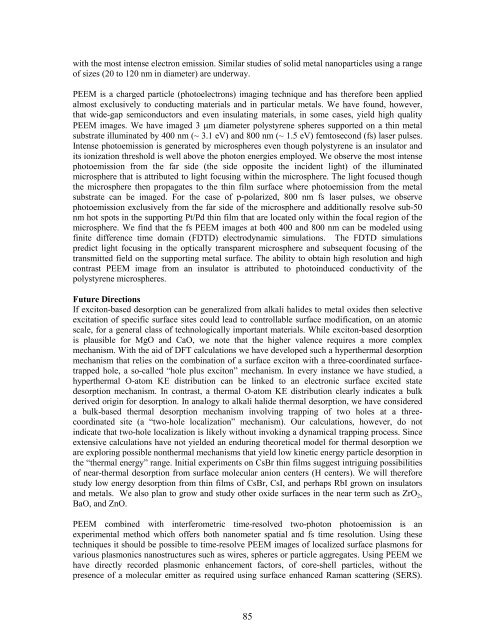Eighth Condensed Phase and Interfacial Molecular Science (CPIMS)
Eighth Condensed Phase and Interfacial Molecular Science (CPIMS)
Eighth Condensed Phase and Interfacial Molecular Science (CPIMS)
Create successful ePaper yourself
Turn your PDF publications into a flip-book with our unique Google optimized e-Paper software.
with the most intense electron emission. Similar studies of solid metal nanoparticles using a range<br />
of sizes (20 to 120 nm in diameter) are underway.<br />
PEEM is a charged particle (photoelectrons) imaging technique <strong>and</strong> has therefore been applied<br />
almost exclusively to conducting materials <strong>and</strong> in particular metals. We have found, however,<br />
that wide-gap semiconductors <strong>and</strong> even insulating materials, in some cases, yield high quality<br />
PEEM images. We have imaged 3 µm diameter polystyrene spheres supported on a thin metal<br />
substrate illuminated by 400 nm (~ 3.1 eV) <strong>and</strong> 800 nm (~ 1.5 eV) femtosecond (fs) laser pulses.<br />
Intense photoemission is generated by microspheres even though polystyrene is an insulator <strong>and</strong><br />
its ionization threshold is well above the photon energies employed. We observe the most intense<br />
photoemission from the far side (the side opposite the incident light) of the illuminated<br />
microsphere that is attributed to light focusing within the microsphere. The light focused though<br />
the microsphere then propagates to the thin film surface where photoemission from the metal<br />
substrate can be imaged. For the case of p-polarized, 800 nm fs laser pulses, we observe<br />
photoemission exclusively from the far side of the microsphere <strong>and</strong> additionally resolve sub-50<br />
nm hot spots in the supporting Pt/Pd thin film that are located only within the focal region of the<br />
microsphere. We find that the fs PEEM images at both 400 <strong>and</strong> 800 nm can be modeled using<br />
finite difference time domain (FDTD) electrodynamic simulations. The FDTD simulations<br />
predict light focusing in the optically transparent microsphere <strong>and</strong> subsequent focusing of the<br />
transmitted field on the supporting metal surface. The ability to obtain high resolution <strong>and</strong> high<br />
contrast PEEM image from an insulator is attributed to photoinduced conductivity of the<br />
polystyrene microspheres.<br />
Future Directions<br />
If exciton-based desorption can be generalized from alkali halides to metal oxides then selective<br />
excitation of specific surface sites could lead to controllable surface modification, on an atomic<br />
scale, for a general class of technologically important materials. While exciton-based desorption<br />
is plausible for MgO <strong>and</strong> CaO, we note that the higher valence requires a more complex<br />
mechanism. With the aid of DFT calculations we have developed such a hyperthermal desorption<br />
mechanism that relies on the combination of a surface exciton with a three-coordinated surfacetrapped<br />
hole, a so-called “hole plus exciton” mechanism. In every instance we have studied, a<br />
hyperthermal O-atom KE distribution can be linked to an electronic surface excited state<br />
desorption mechanism. In contrast, a thermal O-atom KE distribution clearly indicates a bulk<br />
derived origin for desorption. In analogy to alkali halide thermal desorption, we have considered<br />
a bulk-based thermal desorption mechanism involving trapping of two holes at a threecoordinated<br />
site (a “two-hole localization” mechanism). Our calculations, however, do not<br />
indicate that two-hole localization is likely without invoking a dynamical trapping process. Since<br />
extensive calculations have not yielded an enduring theoretical model for thermal desorption we<br />
are exploring possible nonthermal mechanisms that yield low kinetic energy particle desorption in<br />
the “thermal energy” range. Initial experiments on CsBr thin films suggest intriguing possibilities<br />
of near-thermal desorption from surface molecular anion centers (H centers). We will therefore<br />
study low energy desorption from thin films of CsBr, CsI, <strong>and</strong> perhaps RbI grown on insulators<br />
<strong>and</strong> metals. We also plan to grow <strong>and</strong> study other oxide surfaces in the near term such as ZrO2,<br />
BaO, <strong>and</strong> ZnO.<br />
PEEM combined with interferometric time-resolved two-photon photoemission is an<br />
experimental method which offers both nanometer spatial <strong>and</strong> fs time resolution. Using these<br />
techniques it should be possible to time-resolve PEEM images of localized surface plasmons for<br />
various plasmonics nanostructures such as wires, spheres or particle aggregates. Using PEEM we<br />
have directly recorded plasmonic enhancement factors, of core-shell particles, without the<br />
presence of a molecular emitter as required using surface enhanced Raman scattering (SERS).<br />
85
















